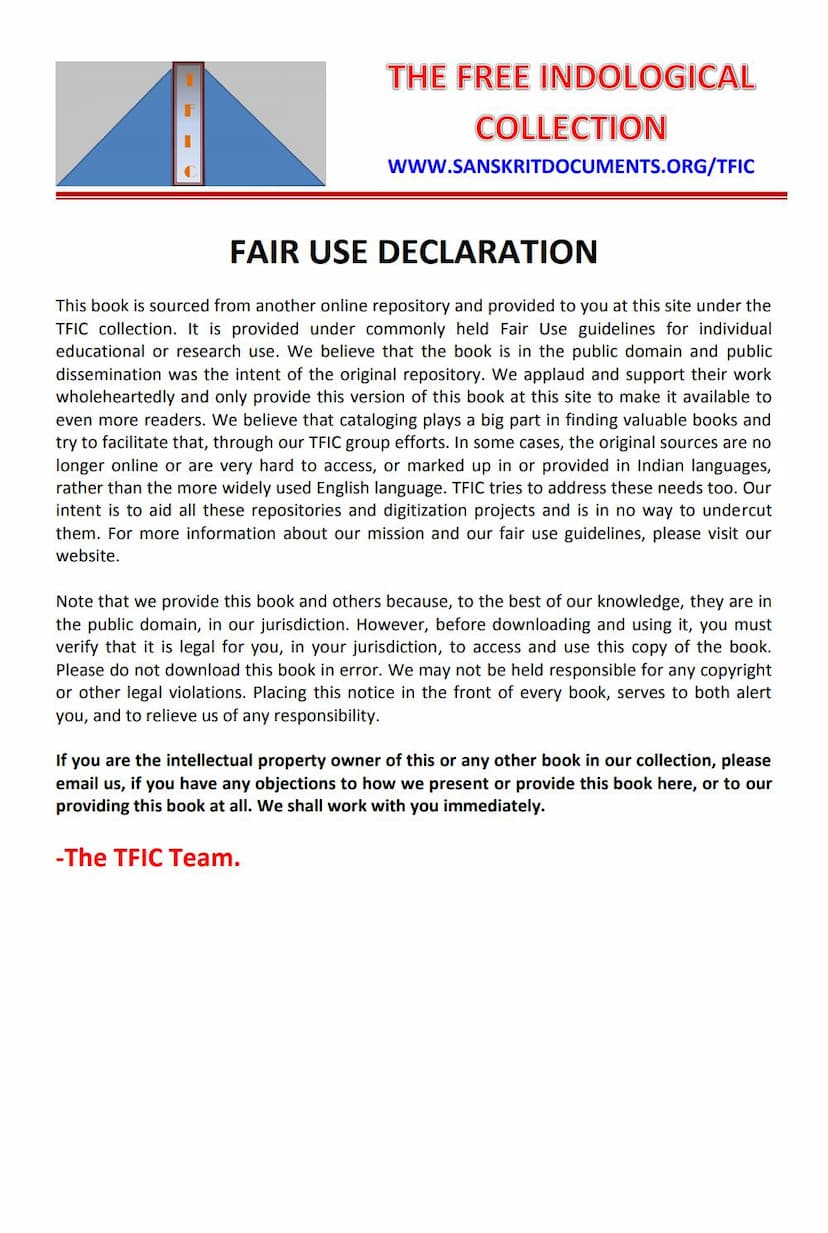Jain Viaha Vidhi
Added to library: September 2, 2025

Summary
This document is a Jain text titled "Jain Vivah Vidhi" (Jain Marriage Rituals) authored and published by Sumerchand Jain. It is intended for private and personal use only and is part of a collection aiming to make Indological texts accessible.
The book aims to provide a simple and accessible guide to Jain marriage ceremonies, compiled according to Jain scriptures and prevailing customs in central India. The author notes that existing books on the subject are often complex, making it difficult for the general public to follow during the actual wedding ceremonies.
The text outlines the purpose of marriage in Jainism as:
- Channeling sexual energy in accordance with societal norms and before esteemed witnesses.
- Focusing sexual desire onto the spouse.
- Binding individuals to the responsibilities of married life.
- Guiding individuals towards spiritual enlightenment by diminishing worldly attachments and drawing their focus inward towards the soul and the ultimate goal of liberation (Moksha).
- Contributing to personal growth, strengthening character, and fostering virtues like love, restraint, sacrifice, service, gentleness, magnanimity, and tolerance.
- Promoting social order, national stability, and peace.
- Ensuring the birth of virtuous offspring who uphold human culture and welfare.
The book emphasizes the importance of remembering the objectives of marriage and glorifying great souls who have achieved these ideals through prayers and praises.
The structure of the book includes detailed procedures for various stages of the wedding:
- Engagement Ceremony (Lagan Vidhi): This involves the establishment of the Siddha Yantra (a sacred diagram) and prayers to the chosen deity.
- Mandap (Canopy) Ceremony: Similar to the engagement, this stage requires the installation of the Siddha Yantra and prayers.
- Horse Procession (Ghurchadhi): Before the procession, the Siddha Yantra is established, and prayers are offered.
- Bridegroom's Arrival (Baitari ki Vidhi): Upon the arrival of the bridegroom, the Siddha Yantra is installed, prayers are performed, and the groom is traditionally marked with a tilak.
- Pledge of Hands (Panigrahan Vidhan): This is the central ceremony, involving eight specific rituals:
- Worship Ritual (Puja Vidhan): A ritualistic worship is performed with the bride and groom together.
- Moli Bandhan and Patka Bandhan: Tying of sacred threads and a ceremonial scarf.
- Recitation of Lineage (Shakhoccharan): Reciting the genealogies and stories of Tirthankaras, particularly Rishabhanatha, and the lineage of the families involved.
- Giving Away the Daughter and Joining Hands (Kanyadan aur Panigrahan): The father of the bride gives her hand to the groom with specific vows.
- Havan (Fire Ritual): The couple performs a fire ritual with specific mantras dedicated to the Panch Parameshthis (five supreme beings) and various Tirthankaras.
- Seven Steps (Saptapadi) and Householder's Duty Sermon: The couple takes seven symbolic steps around the fire, making seven vows to each other, followed by a sermon on the duties of a householder.
- Circumambulation of Fire (Fere): The couple completes seven circumambulations around the sacred fire.
- Peace Chant (Shanti Path): A concluding prayer for peace and well-being.
- Visarjan (Immersion/Conclusion): A prayer for the completion and acceptance of the rituals.
- Stuti (Praise): Various hymns and praises to the deities.
The book also lists the essential items needed for the Puja Vidhan, including:
- Siddha Yantra
- Ashta Mangal Dravya (eight auspicious items)
- Vedi (altar)
- Havan Kund (fire pit)
- Puja Samagri (worship materials like water, sandalwood, rice, flowers, etc.)
- Havan Samagri (materials for the fire ritual like incense, ghee, wood)
- Puja ke Upkaran (worship utensils)
The text provides specific mantras and prayers for each stage of the ceremony, emphasizing devotion to the Panch Parameshthis and Tirthankaras. It includes a detailed list of mantras for the Havan, covering all 24 Tirthankaras. The "Shakhoccharan" section is particularly extensive, narrating the story of Lord Rishabhanatha's marriage.
The book concludes with a Shanti Path and Visarjan, reiterating the importance of Jain principles and seeking blessings for the newly married couple and all present.